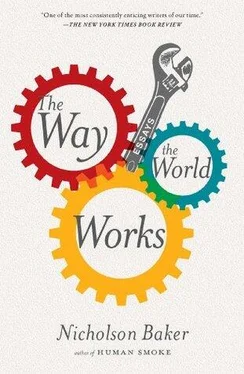Nicholson Baker - The Way the World Works
Здесь есть возможность читать онлайн «Nicholson Baker - The Way the World Works» весь текст электронной книги совершенно бесплатно (целиком полную версию без сокращений). В некоторых случаях можно слушать аудио, скачать через торрент в формате fb2 и присутствует краткое содержание. Год выпуска: 2012, Издательство: Simon & Schuster, Жанр: Публицистика, Критика, на английском языке. Описание произведения, (предисловие) а так же отзывы посетителей доступны на портале библиотеки ЛибКат.
- Название:The Way the World Works
- Автор:
- Издательство:Simon & Schuster
- Жанр:
- Год:2012
- ISBN:нет данных
- Рейтинг книги:4 / 5. Голосов: 1
-
Избранное:Добавить в избранное
- Отзывы:
-
Ваша оценка:
- 80
- 1
- 2
- 3
- 4
- 5
The Way the World Works: краткое содержание, описание и аннотация
Предлагаем к чтению аннотацию, описание, краткое содержание или предисловие (зависит от того, что написал сам автор книги «The Way the World Works»). Если вы не нашли необходимую информацию о книге — напишите в комментариях, мы постараемся отыскать её.
), here assembles his best short pieces from the last fifteen years.
The Way the World Works
OED
Modern Warfare 2
Through all these pieces, many written for
, and
, Baker shines the light of an inexpugnable curiosity.
is a keen-minded, generous-spirited compendium by a modern American master.
The Way the World Works — читать онлайн бесплатно полную книгу (весь текст) целиком
Ниже представлен текст книги, разбитый по страницам. Система сохранения места последней прочитанной страницы, позволяет с удобством читать онлайн бесплатно книгу «The Way the World Works», без необходимости каждый раз заново искать на чём Вы остановились. Поставьте закладку, и сможете в любой момент перейти на страницу, на которой закончили чтение.
Интервал:
Закладка:
Now there are some futurists, some central planners, who don’t agree with any of what I’ve just said. There’s a man named Michael Lesk, of the National Science Foundation in Washington, who is in charge of giving away millions of dollars in federal grants for digital library projects, who told me that he routinely says to libraries, hey, maybe you shouldn’t repair your library building, you could scan everything in that building, and let the building fall down, and you would save money. Lesk refers to an analysis by a library director from Minnesota who claims that libraries would save about 44 billion dollars over the next one hundred years if they digitally scanned about twenty million books and got rid of more than four hundred million duplicate books. Our libraries would be better off, in other words, if they dismantled about 95 percent of their accumulated collections, according to this analysis. Many — not all, but many — in the digital library world believe that the destruction of local research collections will help hurry us toward the far digital shore. They inflate the cost of keeping things, and they denigrate the durability of paper, because it’s distressing to them that it is so inexpensive to store what was long ago bought, cataloged, and shelved.
Research library collections grow. That’s what this fine building recognizes. Your children’s feet grow, and you buy them new shoes — the bigger feet do not represent a “growth problem” but a developmental fact, something to be proud of. For the past half century or more, though, growth has been an embarrassment to some Washington visionaries. They were swept by a kind of Cold War fervor of informational reform, and they wanted all growth to stop. Libraries would reach a certain fixed size, a few million volumes, and then the weeding parties would gather and the microcopying would crunch down the excess, and when the microfilm spools themselves took up too much room, then they could microcopy the microcopies at ultra-high resolution, and crunch things down more, and the stacks would function like a vast trash compactor, squeezing the words. Because words were squeezable, weren’t they? They were disembodied astral presences that had nothing to do with the ink that formed them or the paper that they were printed on or the bindings that held the paper together; they could be “reformatted”—preserved by being destroyed — because they were immaterial; the books would still exist, they would just not exist; they would be there, but they wouldn’t be there; you could hold your head high and say you had the finest U.S. newspaper collection in the world, when in fact you had gotten rid of 90 percent of it and replaced it with microfilm, much of it unchecked for quality.
What was the source of this thinking? There was one especially influential person some of you may have heard about. His name was Fremont Rider, head librarian at Wesleyan. Rider’s first book, published in 1909, was about the amazing discoveries of spirit rappings and table turnings and levitation — he felt these things deserved serious study and that the tables did in fact turn. He wrote pulp fiction and he was the managing editor of Library Journal, and when he went bankrupt in 1929 after a manic episode in which he spent a small fortune founding a high-society supper club on Long Island, he wrote an indignant pamphlet in which he said that people were fed up with being indebted to banks, and they wanted a new deal. He sent the pamphlet to Franklin D. Roosevelt, and Roosevelt shot him back a letter with a handwritten note saying you’re right — keep it up! — and then a few months later Roosevelt, in his nomination speech, pledged himself to a New Deal for the American People. So Fremont Rider was an influential person — and his new deal for librarians was this: make or buy microcopies of your book collection, sell off the book collection to dealers at scrap prices, and you will make, in his words, “an actual cash profit on the substitution.” You’ll enrich your library by getting rid of its books. Rider got the Librarian of Congress and the Deputy Librarian of Congress and the head librarian at Michigan and the head librarian at Harvard and other big-time leaders all over the library world to blurb his book and serve on his Microcard committee. It’s a mathematical fact that book collections double every sixteen years, Rider said (he was wrong about that), and if we didn’t start buying Fremont Rider’s Microcard reading machines and selling off the collections, the stacks were going to overrun the entire square footage of New Jersey. Building a storage warehouse was, according to Rider, “a confession of past failure”—it was unmanly, somehow.
This way of thinking continues in some circles, and it was very powerful in the 1980s, when the Library of Congress had high hopes for its optical disk pilot project, which could, according to the Deputy Librarian, squeeze down the library’s three buildings to one. But the optical disk pilot program didn’t work out — nobody uses those big platters anymore — and over the past decade or so, some enlightened librarians have begun to accept the fact that the easiest way to keep a research collection is to keep the research collection. There is no shame in growth — it is not a confession of failure. Putting up shelves sufficient to hold what’s there is the crucially important primary task that research libraries must fulfill — they must do this because no other institutions, public or private, can be depended on to keep these things — the obscure things, the cumbersome things that even though they’re used only once in ten years or thirty years or fifty years are valuable because they are what people published and read. To a researcher, the fact that something is little used is a positive attribute — if a photo editor for a documentary on, say, Ellis Island pages through a forgotten autobiography and finds a picture that has never been reproduced before, she is overjoyed, because the picture is interesting, and because it is unused. We till around in great collections looking for things that have lain unnoticed — the urge to search through obscurity is basic to scholarship. And if the research libraries don’t keep it — don’t keep copies of the stuff that we as a people publish — nobody else is going to do it. It just won’t happen. We can’t depend on businesses to save our past. The New York Times has kept no run of its own paper, for instance.
We understand why fragile old flags and old presidential letters are valuable as things — we don’t believe that taking a snapshot of Plymouth Rock amounts to a “reformatting” of Plymouth Rock, and after some long and painful decades of urban renewal we’re doing better with old mills and train stations. There are very nice postcards of Whistler’s painting of a woman in a white dress for sale in museum giftshops, but Whistler’s woman in white is still on the wall. Storage! That’s what this building is about. Keep it cool, keep it dry, but above all — keep it. Nice going, Duke.
(2001)
Reading the Paper
An Address Delivered at the Annual Meeting
of the Bibliographical Society of America
Early one morning not long ago, I put on my coat over my pajamas and went out to the end of the driveway to get the paper. It was in a blue bag that said “The New York Times Home Delivery Service,” and “Warning: Keep This Plastic Bag Away From Children.” The bag’s knot was untiable — tied by the deliveryman in the knowledge that each recipient would tear it open and pour out the newspaper, which I did when I got inside. The paper was curled around itself, and when I opened it and began paging through it I could feel in every section the timed-release coolness that is always associated with newsprint. You keep getting outside air on your hands as you read. Newsprint is its own insulation. A single page makes a rattling sound when you turn it, but the whole issue is quiet, muffled by its own layered pulp.
Читать дальшеИнтервал:
Закладка:
Похожие книги на «The Way the World Works»
Представляем Вашему вниманию похожие книги на «The Way the World Works» списком для выбора. Мы отобрали схожую по названию и смыслу литературу в надежде предоставить читателям больше вариантов отыскать новые, интересные, ещё непрочитанные произведения.
Обсуждение, отзывы о книге «The Way the World Works» и просто собственные мнения читателей. Оставьте ваши комментарии, напишите, что Вы думаете о произведении, его смысле или главных героях. Укажите что конкретно понравилось, а что нет, и почему Вы так считаете.












